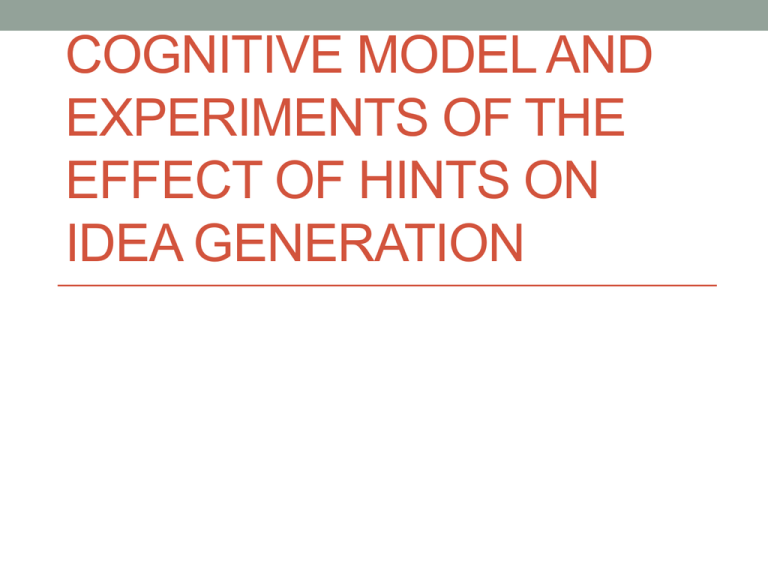COGNITIVE MODEL AND EXPERIMENTS OF THE EFFECT OF HINTS ON IDEA GENERATION
advertisement

COGNITIVE MODEL AND EXPERIMENTS OF THE EFFECT OF HINTS ON IDEA GENERATION Hint Study • Participants given 30 min to come up with ideas to improve the university • 4 Conditions • Hints given every 30 seconds for first 10 min • Hints given every 30 seconds for the middle 10 min • Hints given every 30 seconds for the last 10 min • No hints given Data Collected • Recorded the time each idea was entered and each hint was given • Coded the ideas given for feasibility and effectiveness • Assigned each idea generated to one of 26 categories Analysis Ideas Generated We first analyzed the average number of ideas generated by the participants in each interval Our current goal is to get the output from our model to match the trends we saw in the experimental data Categories • 26 Categories • Found frequency of each category • 6 Common Categories • 7 Semi-Common Categories • 13 Uncommon Categories • Counted number of transitions participants made between categories Transition Table • All zero values replaced with 0.01 • Diagonal shows probability of staying in the same category • Transition table is the input for the model Model • Developed by Vincent Brown • Vincent R. Brown, M. Tumeo, T. Larey and P. B. Paulus: Modeling cognitive interactions during group brainstorming. Journal of Small Group Research, Vol 29, No 4, 1998. Basic Operation • Similar to the study • Each participant gets 180 “steps” • Each step represents 10 seconds in the experiment • Based on transition table probabilities, at each step will generate an idea from one of the 26 categories or category 27 (no idea) Working Memory • Represents a participants short term memory • Starts as 1x26 vector of 0’s each representing a category • When a category is visited by a participant the corresponding vector index is set to 1 • Memory of all inactive categories will decay by working memory decay factor (set around 0.7) Transition Probabilities • Change every step • Active category will decrease by factor of “alpha” (currently set around 0.6) • Inactive categories will slowly increase every step (including null category) • Simulates a participant running out of ideas in a particular category • Will lower chance of same category being visited again in the near future Selecting a Category • Multiply transition table by working memory • Results in 1x27 vector “PC” which holds the probability of each transition the participant can make this step • Stay in same category • Visit one of the 25 other categories • Not generate an idea (null category) Hints • Hints given in same way as in the study • First 10 min, 10-20 min, 20-30 min • Hints given every 3 steps (30 seconds) • Hints are from a randomly selected category based on category frequency • “Hint attention factor” determines if participant will pay attention to a particular hint or ignore it. • If they pay attention, they jump to the hints category • If participant is in the null category they will always pay attention to a presented hint Results Ideas Generated by Interval 46 44 42 Ideas Generated 40 38 No Hint First 10 36 Middle 10 Last 10 34 32 30 28 0 1 2 Interval 3 4 Compared to Study Ideas Generated by Interval 46 44 42 Ideas Generated 40 38 36 34 No Hint First 10 32 Middle 10 30 Last 10 28 0 1 2 Interval 3 4 Future Changes Issues • In model idea generation drops off too quickly after a hint interval • The hint conditions are matching the no hint condition too closely Possible Solutions • Currently “alpha” variable is constant throughout the whole experiment. • Looking into adding a motivation factor to change alpha as the experiment progresses • Represent participants loss of motivation to generate new ideas

